Jiaqing Zhang
Quantifying Circadian Desynchrony in ICU Patients and Its Association with Delirium
Mar 11, 2025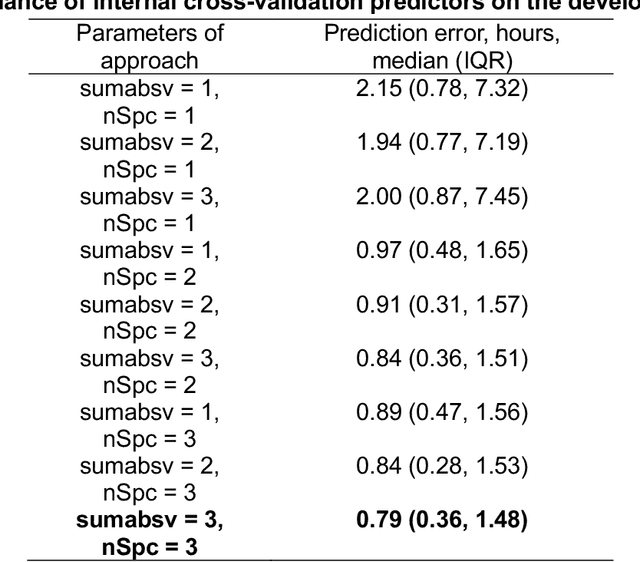
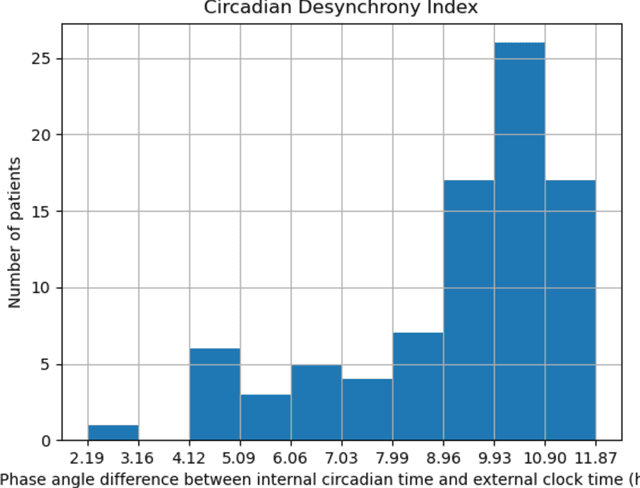


Abstract:Background: Circadian desynchrony characterized by the misalignment between an individual's internal biological rhythms and external environmental cues, significantly affects various physiological processes and health outcomes. Quantifying circadian desynchrony often requires prolonged and frequent monitoring, and currently, an easy tool for this purpose is missing. Additionally, its association with the incidence of delirium has not been clearly explored. Methods: A prospective observational study was carried out in intensive care units (ICU) of a tertiary hospital. Circadian transcriptomics of blood monocytes from 86 individuals were collected on two consecutive days, although a second sample could not be obtained from all participants. Using two public datasets comprised of healthy volunteers, we replicated a model for determining internal circadian time. We developed an approach to quantify circadian desynchrony by comparing internal circadian time and external blood collection time. We applied the model and quantified circadian desynchrony index among ICU patients, and investigated its association with the incidence of delirium. Results: The replicated model for determining internal circadian time achieved comparable high accuracy. The quantified circadian desynchrony index was significantly higher among critically ill ICU patients compared to healthy subjects, with values of 10.03 hours vs 2.50-2.95 hours (p < 0.001). Most ICU patients had a circadian desynchrony index greater than 9 hours. Additionally, the index was lower in patients whose blood samples were drawn after 3pm, with values of 5.00 hours compared to 10.01-10.90 hours in other groups (p < 0.001)...
M$^3$amba: CLIP-driven Mamba Model for Multi-modal Remote Sensing Classification
Mar 09, 2025Abstract:Multi-modal fusion holds great promise for integrating information from different modalities. However, due to a lack of consideration for modal consistency, existing multi-modal fusion methods in the field of remote sensing still face challenges of incomplete semantic information and low computational efficiency in their fusion designs. Inspired by the observation that the visual language pre-training model CLIP can effectively extract strong semantic information from visual features, we propose M$^3$amba, a novel end-to-end CLIP-driven Mamba model for multi-modal fusion to address these challenges. Specifically, we introduce CLIP-driven modality-specific adapters in the fusion architecture to avoid the bias of understanding specific domains caused by direct inference, making the original CLIP encoder modality-specific perception. This unified framework enables minimal training to achieve a comprehensive semantic understanding of different modalities, thereby guiding cross-modal feature fusion. To further enhance the consistent association between modality mappings, a multi-modal Mamba fusion architecture with linear complexity and a cross-attention module Cross-SS2D are designed, which fully considers effective and efficient information interaction to achieve complete fusion. Extensive experiments have shown that M$^3$amba has an average performance improvement of at least 5.98\% compared with the state-of-the-art methods in multi-modal hyperspectral image classification tasks in the remote sensing field, while also demonstrating excellent training efficiency, achieving a double improvement in accuracy and efficiency. The code is released at https://github.com/kaka-Cao/M3amba.
MANDARIN: Mixture-of-Experts Framework for Dynamic Delirium and Coma Prediction in ICU Patients: Development and Validation of an Acute Brain Dysfunction Prediction Model
Mar 08, 2025Abstract:Acute brain dysfunction (ABD) is a common, severe ICU complication, presenting as delirium or coma and leading to prolonged stays, increased mortality, and cognitive decline. Traditional screening tools like the Glasgow Coma Scale (GCS), Confusion Assessment Method (CAM), and Richmond Agitation-Sedation Scale (RASS) rely on intermittent assessments, causing delays and inconsistencies. In this study, we propose MANDARIN (Mixture-of-Experts Framework for Dynamic Delirium and Coma Prediction in ICU Patients), a 1.5M-parameter mixture-of-experts neural network to predict ABD in real-time among ICU patients. The model integrates temporal and static data from the ICU to predict the brain status in the next 12 to 72 hours, using a multi-branch approach to account for current brain status. The MANDARIN model was trained on data from 92,734 patients (132,997 ICU admissions) from 2 hospitals between 2008-2019 and validated externally on data from 11,719 patients (14,519 ICU admissions) from 15 hospitals and prospectively on data from 304 patients (503 ICU admissions) from one hospital in 2021-2024. Three datasets were used: the University of Florida Health (UFH) dataset, the electronic ICU Collaborative Research Database (eICU), and the Medical Information Mart for Intensive Care (MIMIC)-IV dataset. MANDARIN significantly outperforms the baseline neurological assessment scores (GCS, CAM, and RASS) for delirium prediction in both external (AUROC 75.5% CI: 74.2%-76.8% vs 68.3% CI: 66.9%-69.5%) and prospective (AUROC 82.0% CI: 74.8%-89.2% vs 72.7% CI: 65.5%-81.0%) cohorts, as well as for coma prediction (external AUROC 87.3% CI: 85.9%-89.0% vs 72.8% CI: 70.6%-74.9%, and prospective AUROC 93.4% CI: 88.5%-97.9% vs 67.7% CI: 57.7%-76.8%) with a 12-hour lead time. This tool has the potential to assist clinicians in decision-making by continuously monitoring the brain status of patients in the ICU.
TD3: Tucker Decomposition Based Dataset Distillation Method for Sequential Recommendation
Feb 06, 2025



Abstract:In the era of data-centric AI, the focus of recommender systems has shifted from model-centric innovations to data-centric approaches. The success of modern AI models is built on large-scale datasets, but this also results in significant training costs. Dataset distillation has emerged as a key solution, condensing large datasets to accelerate model training while preserving model performance. However, condensing discrete and sequentially correlated user-item interactions, particularly with extensive item sets, presents considerable challenges. This paper introduces \textbf{TD3}, a novel \textbf{T}ucker \textbf{D}ecomposition based \textbf{D}ataset \textbf{D}istillation method within a meta-learning framework, designed for sequential recommendation. TD3 distills a fully expressive \emph{synthetic sequence summary} from original data. To efficiently reduce computational complexity and extract refined latent patterns, Tucker decomposition decouples the summary into four factors: \emph{synthetic user latent factor}, \emph{temporal dynamics latent factor}, \emph{shared item latent factor}, and a \emph{relation core} that models their interconnections. Additionally, a surrogate objective in bi-level optimization is proposed to align feature spaces extracted from models trained on both original data and synthetic sequence summary beyond the na\"ive performance matching approach. In the \emph{inner-loop}, an augmentation technique allows the learner to closely fit the synthetic summary, ensuring an accurate update of it in the \emph{outer-loop}. To accelerate the optimization process and address long dependencies, RaT-BPTT is employed for bi-level optimization. Experiments and analyses on multiple public datasets have confirmed the superiority and cross-architecture generalizability of the proposed designs. Codes are released at https://github.com/USTC-StarTeam/TD3.
MANGO: Multimodal Acuity traNsformer for intelliGent ICU Outcomes
Dec 13, 2024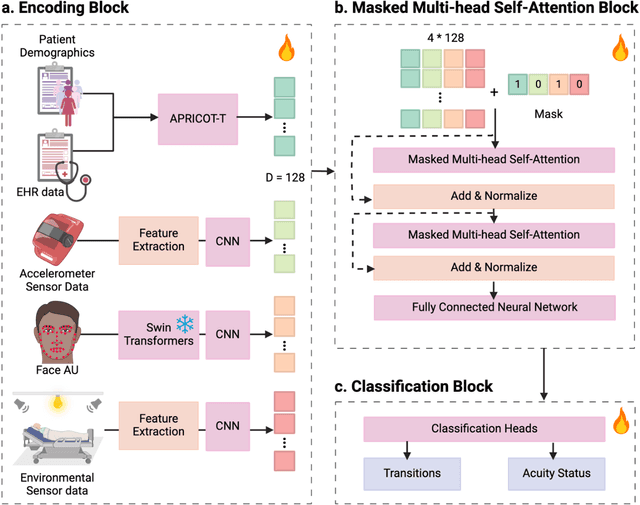
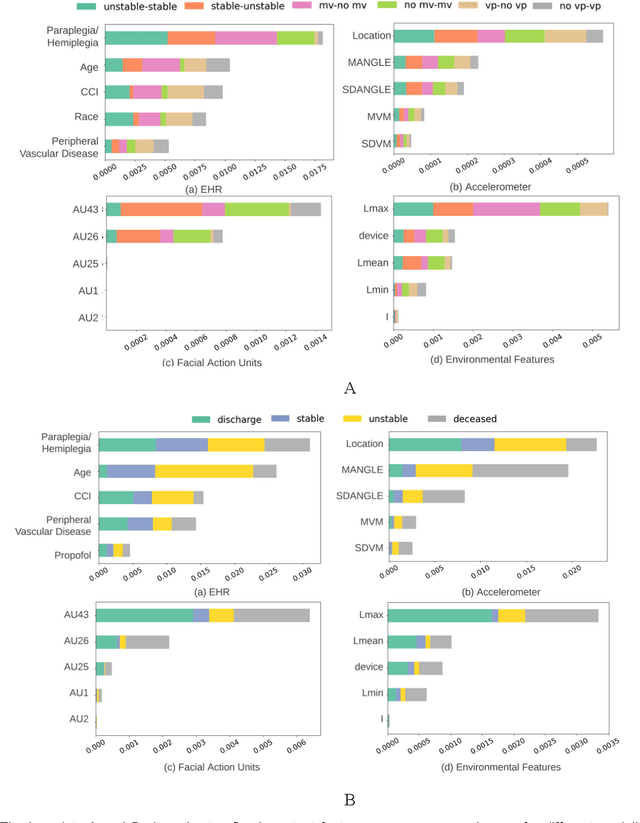
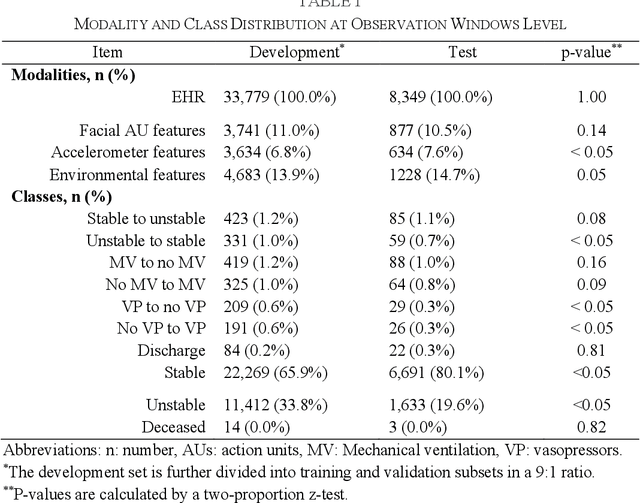
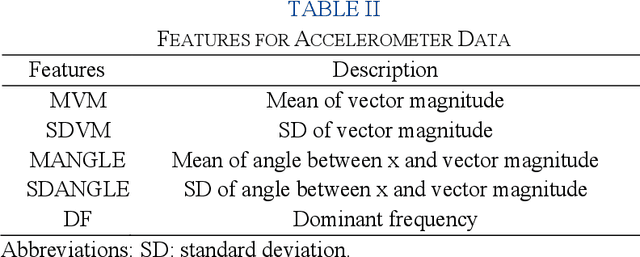
Abstract:Estimation of patient acuity in the Intensive Care Unit (ICU) is vital to ensure timely and appropriate interventions. Advances in artificial intelligence (AI) technologies have significantly improved the accuracy of acuity predictions. However, prior studies using machine learning for acuity prediction have predominantly relied on electronic health records (EHR) data, often overlooking other critical aspects of ICU stay, such as patient mobility, environmental factors, and facial cues indicating pain or agitation. To address this gap, we present MANGO: the Multimodal Acuity traNsformer for intelliGent ICU Outcomes, designed to enhance the prediction of patient acuity states, transitions, and the need for life-sustaining therapy. We collected a multimodal dataset ICU-Multimodal, incorporating four key modalities, EHR data, wearable sensor data, video of patient's facial cues, and ambient sensor data, which we utilized to train MANGO. The MANGO model employs a multimodal feature fusion network powered by Transformer masked self-attention method, enabling it to capture and learn complex interactions across these diverse data modalities even when some modalities are absent. Our results demonstrated that integrating multiple modalities significantly improved the model's ability to predict acuity status, transitions, and the need for life-sustaining therapy. The best-performing models achieved an area under the receiver operating characteristic curve (AUROC) of 0.76 (95% CI: 0.72-0.79) for predicting transitions in acuity status and the need for life-sustaining therapy, while 0.82 (95% CI: 0.69-0.89) for acuity status prediction...
DiffCLIP: Few-shot Language-driven Multimodal Classifier
Dec 10, 2024



Abstract:Visual language models like Contrastive Language-Image Pretraining (CLIP) have shown impressive performance in analyzing natural images with language information. However, these models often encounter challenges when applied to specialized domains such as remote sensing due to the limited availability of image-text pairs for training. To tackle this issue, we introduce DiffCLIP, a novel framework that extends CLIP to effectively convey comprehensive language-driven semantic information for accurate classification of high-dimensional multimodal remote sensing images. DiffCLIP is a few-shot learning method that leverages unlabeled images for pretraining. It employs unsupervised mask diffusion learning to capture the distribution of diverse modalities without requiring labels. The modality-shared image encoder maps multimodal data into a unified subspace, extracting shared features with consistent parameters across modalities. A well-trained image encoder further enhances learning by aligning visual representations with class-label text information from CLIP. By integrating these approaches, DiffCLIP significantly boosts CLIP performance using a minimal number of image-text pairs. We evaluate DiffCLIP on widely used high-dimensional multimodal datasets, demonstrating its effectiveness in addressing few-shot annotated classification tasks. DiffCLIP achieves an overall accuracy improvement of 10.65% across three remote sensing datasets compared with CLIP, while utilizing only 2-shot image-text pairs. The code has been released at https://github.com/icey-zhang/DiffCLIP.
Peri-AIIMS: Perioperative Artificial Intelligence Driven Integrated Modeling of Surgeries using Anesthetic, Physical and Cognitive Statuses for Predicting Hospital Outcomes
Oct 29, 2024



Abstract:The association between preoperative cognitive status and surgical outcomes is a critical, yet scarcely explored area of research. Linking intraoperative data with postoperative outcomes is a promising and low-cost way of evaluating long-term impacts of surgical interventions. In this study, we evaluated how preoperative cognitive status as measured by the clock drawing test contributed to predicting length of hospital stay, hospital charges, average pain experienced during follow-up, and 1-year mortality over and above intraoperative variables, demographics, preoperative physical status and comorbidities. We expanded our analysis to 6 specific surgical groups where sufficient data was available for cross-validation. The clock drawing images were represented by 10 constructional features discovered by a semi-supervised deep learning algorithm, previously validated to differentiate between dementia and non-dementia patients. Different machine learning models were trained to classify postoperative outcomes in hold-out test sets. The models were compared to their relative performance, time complexity, and interpretability. Shapley Additive Explanations (SHAP) analysis was used to find the most predictive features for classifying different outcomes in different surgical contexts. Relative classification performances achieved by different feature sets showed that the perioperative cognitive dataset which included clock drawing features in addition to intraoperative variables, demographics, and comorbidities served as the best dataset for 12 of 18 possible surgery-outcome combinations...
DeLLiriuM: A large language model for delirium prediction in the ICU using structured EHR
Oct 22, 2024



Abstract:Delirium is an acute confusional state that has been shown to affect up to 31% of patients in the intensive care unit (ICU). Early detection of this condition could lead to more timely interventions and improved health outcomes. While artificial intelligence (AI) models have shown great potential for ICU delirium prediction using structured electronic health records (EHR), most of them have not explored the use of state-of-the-art AI models, have been limited to single hospitals, or have been developed and validated on small cohorts. The use of large language models (LLM), models with hundreds of millions to billions of parameters, with structured EHR data could potentially lead to improved predictive performance. In this study, we propose DeLLiriuM, a novel LLM-based delirium prediction model using EHR data available in the first 24 hours of ICU admission to predict the probability of a patient developing delirium during the rest of their ICU admission. We develop and validate DeLLiriuM on ICU admissions from 104,303 patients pertaining to 195 hospitals across three large databases: the eICU Collaborative Research Database, the Medical Information Mart for Intensive Care (MIMIC)-IV, and the University of Florida Health's Integrated Data Repository. The performance measured by the area under the receiver operating characteristic curve (AUROC) showed that DeLLiriuM outperformed all baselines in two external validation sets, with 0.77 (95% confidence interval 0.76-0.78) and 0.84 (95% confidence interval 0.83-0.85) across 77,543 patients spanning 194 hospitals. To the best of our knowledge, DeLLiriuM is the first LLM-based delirium prediction tool for the ICU based on structured EHR data, outperforming deep learning baselines which employ structured features and can provide helpful information to clinicians for timely interventions.
SeaDATE: Remedy Dual-Attention Transformer with Semantic Alignment via Contrast Learning for Multimodal Object Detection
Oct 15, 2024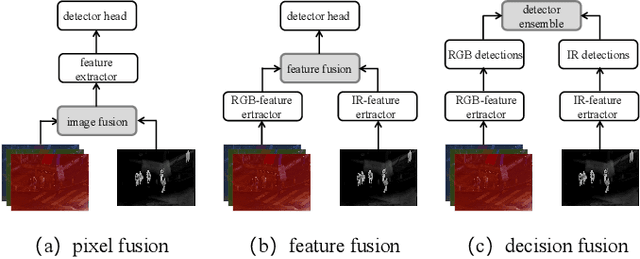
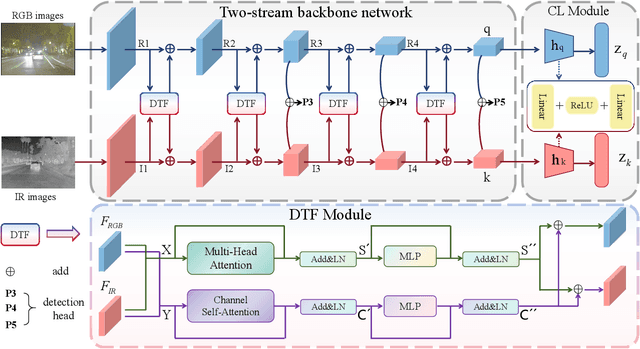
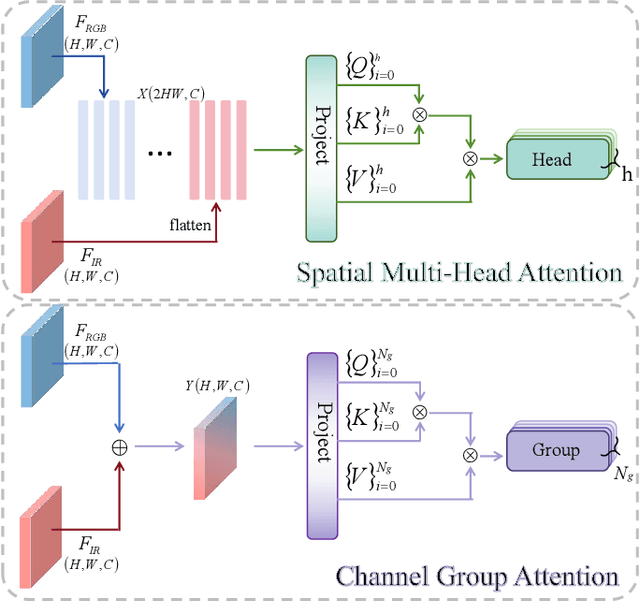
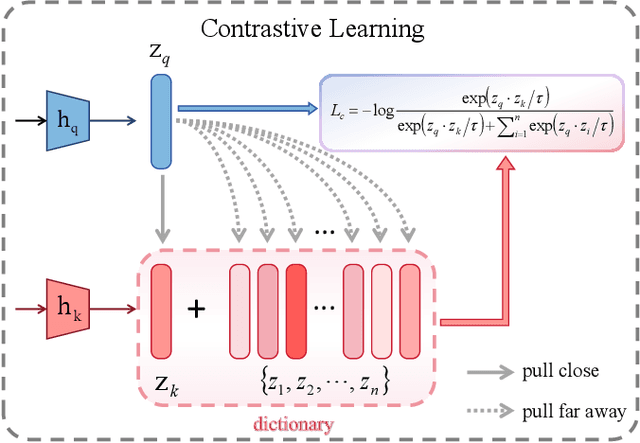
Abstract:Multimodal object detection leverages diverse modal information to enhance the accuracy and robustness of detectors. By learning long-term dependencies, Transformer can effectively integrate multimodal features in the feature extraction stage, which greatly improves the performance of multimodal object detection. However, current methods merely stack Transformer-guided fusion techniques without exploring their capability to extract features at various depth layers of network, thus limiting the improvements in detection performance. In this paper, we introduce an accurate and efficient object detection method named SeaDATE. Initially, we propose a novel dual attention Feature Fusion (DTF) module that, under Transformer's guidance, integrates local and global information through a dual attention mechanism, strengthening the fusion of modal features from orthogonal perspectives using spatial and channel tokens. Meanwhile, our theoretical analysis and empirical validation demonstrate that the Transformer-guided fusion method, treating images as sequences of pixels for fusion, performs better on shallow features' detail information compared to deep semantic information. To address this, we designed a contrastive learning (CL) module aimed at learning features of multimodal samples, remedying the shortcomings of Transformer-guided fusion in extracting deep semantic features, and effectively utilizing cross-modal information. Extensive experiments and ablation studies on the FLIR, LLVIP, and M3FD datasets have proven our method to be effective, achieving state-of-the-art detection performance.
FusionSAM: Latent Space driven Segment Anything Model for Multimodal Fusion and Segmentation
Aug 26, 2024
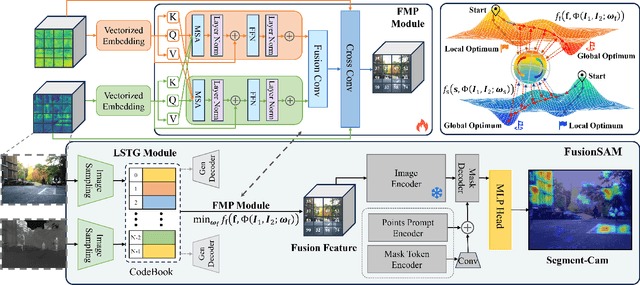
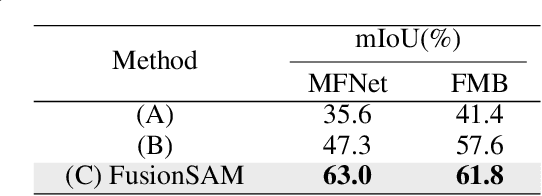

Abstract:Multimodal image fusion and segmentation enhance scene understanding in autonomous driving by integrating data from various sensors. However, current models struggle to efficiently segment densely packed elements in such scenes, due to the absence of comprehensive fusion features that can guide mid-process fine-tuning and focus attention on relevant areas. The Segment Anything Model (SAM) has emerged as a transformative segmentation method. It provides more effective prompts through its flexible prompt encoder, compared to transformers lacking fine-tuned control. Nevertheless, SAM has not been extensively studied in the domain of multimodal fusion for natural images. In this paper, we introduce SAM into multimodal image segmentation for the first time, proposing a novel framework that combines Latent Space Token Generation (LSTG) and Fusion Mask Prompting (FMP) modules to enhance SAM's multimodal fusion and segmentation capabilities. Specifically, we first obtain latent space features of the two modalities through vector quantization and embed them into a cross-attention-based inter-domain fusion module to establish long-range dependencies between modalities. Then, we use these comprehensive fusion features as prompts to guide precise pixel-level segmentation. Extensive experiments on several public datasets demonstrate that the proposed method significantly outperforms SAM and SAM2 in multimodal autonomous driving scenarios, achieving at least 3.9$\%$ higher segmentation mIoU than the state-of-the-art approaches.
 Add to Chrome
Add to Chrome Add to Firefox
Add to Firefox Add to Edge
Add to Edge